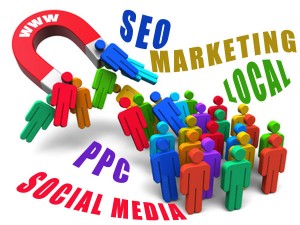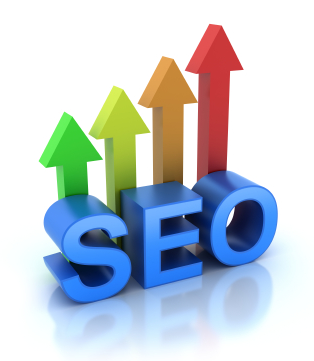Building organic traffic is the most effective way to grow your online business. While using tactics such as PPC and online advertising can get eyeballs to your site and can serve as a major part of an online marketing campaign, organic traffic that naturally flows to your site has its own benefits. When you reach customers organically, you build online loyalty and trust and increase the likelihood that they will share your site with their friends and family, helping it to “go viral” and grow quickly.

So what is the best way to do this? eVisible has many different tactics that we use with customers to building organic traffic. Here are three that have proven to be the most effective:
Publishing Early and Often: You don’t want to have a limited amount of content available when you first launch; similarly, you don’t want to publish all of your content right away and then go weeks or even months before you add new content. Make sure you are publishing multiple pieces of content every day and try to publish three or four times a day in the early stages of your launch.
Listen to Your Customers: By doing the proper market research, you can have a strong idea of which topics are right for your initial content rollout. eVisible’s simple keyword research tool will give you a good idea about which topics will naturally fit the keywords you want to target. From there, keep an eye on your metrics and see which topics are getting views and shares; you’ll want to increase your attention on these, since it’s clear it’s what customers are interested in reading more about.
Back Your Content Up With Facts: When you first launch your site, you won’t have the credibility and trust that an established website will have with readers. One way to gain the trust of your readers is to publish content loaded with references to factual information. Including links to research, analysis and news from trusted sources makes you look more reliable in the process.
SEO practices can go a long way in impacting your Search Engine Results Placement (SERP). Producing the right content and using best SEO practices such as authorship, site links and social signals can improve the SERP display of a website page on a search engine query. But this is only part of the battle. In order to profit from a high SERP, you need to be able to get people to click through to your link. With higher SERP conversion, your high-ranking link is as worthless as one that is at the bottom of the search engine rankings.
SERP conversion is often an overlooked element of search engine optimization. However, it should be an important part of any SEO conversion strategy. Organic clickthough strategies are proven to lead to an increase in highly targeted and motivated visitors to your site who are ready to make purchasing decisions. Ultimately, that’s the goal of any online marketing campaign – get qualified leads ready to buy to your site.

Over the years, we’ve developed many different strategies to improve organic clickthrough rates. The right strategy for you will depend on your unique position, but these five strategies have been proven to work over time:
Rich snippets such as ratings, number of total reviews, price range and contact information can go a long way in getting people to click on a link. This is even more powerful when combined with strong calls to action to “see pictures” or “read unbiased reviews.”
Building a brand through offline tactics can help your SEO strategy. Google rewards links associated with known brands. Running contests and offsite promotions are some of the ways that you can create positive association with customers and get them interested in clicking on your link.
Harness multimedia by going beyond text. Create videos and use attention-grabbing images. Make sure to caption and tag them for full optimization.
Optimize your site by reviewing your internal linking strategy and site structure. Research how customers are viewing your site so you can create breadcrumbs in your search results.
Take ownership of your content by attaching your company’s name – or your name – to the great content you are creating. It establishes credibility with searchers and helps with your Google ranking.
Organic search results are one of the most powerful tools in online marketing. But even if your search engine optimization leads to your results being at the top of the Google rankings, users might overlook them if the listing doesn’t grab their attention. Here are seven ways to improve your rates of SERP conversion for organic listings.
1. Title tags and meta tags are what tell users what to expect when they click on a link. Spend time on developing these with your audience in mind.
2. Brand awareness encourages people to click on a link. Offsite promotional tools can be a factor in increasing the number of clicks on your links.
3. Rich snippets such as ratings, reviews, photos and videos attract immediate attention. Make sure you are using the tools Google supplies to markup your content.

4. Authorship of content looks great in the eyes of Google. Along with a bio, consider linking stories to an author’s Google Plus account.
5. Multimedia elements such as videos and images are powerful ways to improve SERP conversion. Make sure you properly tag, caption, organize and promote your multimedia content.
6. Core optimization is at the heart of any search engine optimization campaign. This extends beyond linking your keywords and performing code tag optimization. You need to make sure that your entire site is optimized so that Google and other search engines can easily find and index your content. eVisible can help you to review your site architecture, internal linking and more to make your site ready for indexing.
7. Review your SERP results and tweak your content frequently. Old content is stale content. Using technology to track the performance of your SEO content can give you clues on how to improve your SERP conversion rates.
A press release about your company and its products serves multiple purposes. By working with a company like eVisible for press release optimization, it can help your overall SEO strategy. But it’s easy to forget that a press release is ultimately a marketing tool to promote your goods and services. If you want to craft more effective press releases, here are five tips to consider:
1. Make Your Content Newsworthy. Remember that there is a difference between a press release and an advertisement. Reporters and editors want to feel like they are passing on useful information to their readers rather than simply acting as a press release distribution service and providing free marketing for companies.
2. Avoid Buzzwords. You’ve probably read press releases that talk about “synergy,” “shifting the paradigm” or any other number of buzzwords and phrases. The truth is that it just makes your press release sound forced and dated, and readers might miss the point. Professionals at press release writing services know that it’s best to speak down-to-Earth with readers, using plain English that’s free of jargon.

3. Speak to Your Audience. This doesn’t just apply to the readers. Reporters hate getting press releases relating to topics they don’t cover. It wastes their time and gives your company a bad name.
4. Don’t Oversell. Reporters can tell when a press release is trying too hard to hype a product as the “greatest” or “world’s best.” Stick to the facts and what your product does, and a reporter can tell if it’s worth writing about.
5. Format Your Press Release. The best type of press release gets all of the relevant information out in the first few paragraphs. A press release submission service like eVisible can help you to craft a release that immediately grabs a reader’s attention.
One of the most difficult parts of a website optimization campaign is analytics. With many data points to choose from when looking at your landing page optimization campaign, it’s easy to overlook some of the most important elements. Here are six analytic points you need to pay attention to:
Entry Pages: A lot of emphasis is placed on home pages in website analytics. But landing pages and product pages are also critical to the success of your site. One of the best things to analyze on an entry page is the last action a person took before leaving. It might tell you what was frustrating on the site and caused them to quit.
Meeting Sales Goals: The main goal of almost any website optimization campaign is to increase landing page conversion and turn clicks into sales. But too many people get bogged down in the minute details of their web campaign and lose focus on tracking their sales performance. Most solid analytics tools have the ability to set and track eCommerce goals.

Web Form Stats: Your web forms are critical to your landing page conversion rate. Whether its customers asking for more information on your services or a shopping cart or payment page to complete a transaction, you need to know if customers are filling out forms once they get to the final step in the process.
Search Keywords: Finding the right keywords to focus your optimization efforts is a critical aspect of your SEO campaign. Before you do this, you’ll want to see how people are finding your site now. If the majority of customers found it by searching for your “brand name,” you aren’t doing enough to attract new customers. More generic keywords will be effective search keywords to optimize.
Traffic Sources: It’s easy to become so wrapped up in detailed web analytics and forget about one of the most basic pieces of data: where your web traffic is coming from. Determining if visitors are coming because of web searches, referrals or ad campaigns will help you understand which tactics can potentially have the best results.
Actual Website Traffic: Did you know that many website visits aren’t from real customers but from search engine robots and spiders that crawl Internet sites regularly? Most web visits that last 10 seconds or less are useless to you. Focus on lengthier visits to get a more accurate reflection of your web campaign.
Although some people are unfamiliar with A/B testing, it’s actually a very simple concept to grasp. It’s a frequent tool used in landing page optimization to test potential changes to your existing home page. In this version of landing page testing, visitors potentially see one of two pages: the current one or the new, experimental page. This gives you the ability to get real-world data in a short amount of time to determine which page works better and the strengths and weaknesses of various elements of your site.
Even people who understand what A/B testing is all about often don’t do it frequently enough. Often it’s something that is done when a website first launches or a business first undertakes a campaign of optimizing landing pages. However, what they don’t realize is that A/B testing can be a powerful tool throughout the life cycle of your website. In an article at Quick Sprout, Neil Patel recommends running an A/B test at least every one to two months for websites with more than 10,000 monthly visitors. Patel runs A/B testing twice a month for his business and claims that one out of every four test yields results that increase landing page conversion rates by 20 percent.

A/B testing isn’t just for elements on your website. You can also perform basic tests on the ads as part of your PPC advertising campaigns. Even if your Pay Per Click advertising campaigns are having success at the moment, this doesn’t mean that they are as successful as they could be. Trying out new elements in your campaign and comparing them to your existing elements can help you to understand what is working and what can work better. It doesn’t have to be a major overhaul – according to Patel, even some minor tweaks can provide major benefits to your Pay Per Click advertising conversion rates.
Here are three tips from Patel that you’ll want to consider during A/B testing:
People Love Free Things: Simply adding the word “free” to your advertising can have a huge impact on click-through rates. People are attracted to the concept of getting something for nothing and generally want to read more if something is offered to them for free. If you are already using “free” in your PPC ads, consider highlighting the word through colors, font or sizes.
Place a Value on Your Free Things: People also want to know just what a great bargain they are getting. If you can, make sure you place a dollar amount on the value of the free item or service you are “giving away” on your site.
People Also Love Videos: Many people will click on a video to learn the same information available in text form on a website. Simple videos can be cheap to produce with a provider of PPC advertising services but pay huge dividends.
It’s easy to make the assumption that the search engine optimization strategy for Enterprise SEO — when you are working with a large corporation’s website — would be the same as SEO work for a startup or smaller company. But while many of the same principles remain, there are several major differences between standard SEO and search engine marketing at an Enterprise level.
Many of these issues come from the challenges of doing SEO work as part of a large business. As P.J. Fusco wrote about for Search Engine Watch, departmental barriers often make it difficult for someone doing Enterprise SEO (https://searchenginewatch.com/article/2236950/Enterprise-SEO-in-2013) to produce acceptable results from their SEO campaigns. When someone does search engine optimization consulting for small businesses, they have few approvals to get and can alter their SEO strategies quickly to react to changing search engine algorithms and other factors.

This isn’t the case when you are doing SEO consulting services or working in-house at an Enterprise-level business. The layers of management and departments means that you need “buy-in” from many people to implement an SEO campaign or to make changes to an existing campaign. This can be a major problem — especially if some of the people you need to work with are unfamiliar with the concepts of professional search engine marketing.
So how can you overcome these obstacles? One good tip was recently shared by Ray Comstock in Search Engine Watch (https://searchenginewatch.com/article/2234928/Defining-an-Enterprise-SEO-Strategy). Comstock recommends that you break your campaign up into two parts — a “foundational” stage where you are doing the keyword research and other background along with the early implementation and a “continuous” phase that includes the steps needed to keep your campaign moving through the long haul. This can include link acquisition, social media marketing services and more. Content writing services are a major part throughout all phases.
Another way to reduce headaches in Enterprise SEO is to conduct training with the key personnel who will be involved ahead of time. Chances are that you are the expert in online marketing services within your company, so you need to educate other people on what you know. Everyone understands the importance of ranking highly but they might not grasp the steps that need to happen to improve your search engine ranking. Getting people inside and outside of your circle educated on the different elements of Enterprise SEO will allow you to all speak the same language and improve communications as you move forward with your campaign.
When you are in the middle of a search engine optimization campaign, it’s easy to lose focus on the big picture because you so concerned with managing every minute aspect of your optimization. It’s great to be focused on details; this focus helps you stay on top of your rankings and make changes as needed. But it’s just as easy to get so concerned with the smallest features that you forget about the reason you are doing optimization in the first place — driving business to your site through an improved search engine ranking.
Over the years, eVisible has learned some valuable lessons about how to maintain the proper focus while undertaking a search engine optimization campaign. Here are three things to keep in mind as your campaign progresses but before you get overwhelmed with every little detail:
ROI, ROI and More ROI
The reason that businesses undertake an SEO campaign in the first place is to increase their visibility and get more customers and sales. After all, if you aren’t making money, why do SEO in the first place? As you progress through your campaign, make sure that you and your online marketing services provider stay focused on the tactics that will give you the greatest impact to your bottom line for the least amount of money.
Don’t Just Focus on Content
Content is an important aspect of search engine optimization. But if it’s the only thing that you are doing as part of your online marketing, you are missing out on a lot of potentially valuable tactics. Improving your site’s architecture will make it easier for search engine spiders to find your pages and for you to receive inbound links. In addition, working with a viral marketing agency to improve your social media platform or start an ad campaign can increase your visibility along with boosting your SEO rankings.
Be Flexible with Your Campaign
Developing a solid game plan is critical to having success with your SEO campaign and achieving higher search engine rankings. However, you need to look at it as a starting point rather than a script from which you can never deviate. The world of online rankings is extremely fluid and you need to be able to adjust on a regular basis as well. Major search engines tweak their ranking algorithms hundreds of times each year and you need to be open to change as well. Your provider of SEO services should be able to stay on top of any movements in the ways that search engines rank sites and make recommendations for updates to your tactics.
 Posted on June 27, 2013
Posted on June 27, 2013
 Posted on May 9, 2013
Posted on May 9, 2013
 Posted on April 24, 2013
Posted on April 24, 2013
 Posted on April 9, 2013
Posted on April 9, 2013

 Posted on February 18, 2013
Posted on February 18, 2013
 Posted on January 31, 2013
Posted on January 31, 2013